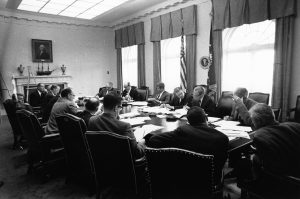By Meyer Thalheimer
Last week at the Ploughshares event, “Nuclear Weapons Policy in a Time of Crisis,” former Secretary of Defense William Perry was asked to reflect on his memories of the Cuban Missile Crisis. During the crisis, he was analyzing Russian missiles to assist U.S. intelligence capabilities. “I believed then that every day that I went into that analysis center was going to be my last day on Earth,” he said.
Luckily, a global conflagration was narrowly averted, but the events of Black Saturday — 55 years ago last Friday — are a chilling reminder of how close we came to the brink. Murphy’s Law was in overdrive, with almost everything going wrong over the span of 24 hours. As Secretary Perry noted in his speech, neither Kennedy nor Khrushchev wanted a nuclear war. Nevertheless, both sides were operating with incomplete information and as the historical record shows, decisions that were thought to be safe were, in fact, anything but.
The day opened with a letter from Khrushchev with a new condition for resolving the conflict, a demand that the United States withdraw its deployed Jupiter missiles from Turkey. Khrushchev argued, “[D]o you consider, then, that you have the right to demand security for your own country and the removal of the weapons you call offensive, but do not accord the same right to us?” These missiles had been deployed only recently, and the Administration was already considering withdrawing them, as the development of the Polaris submarine-launched missiles rendered them obsolete. However, the Executive Committee of the National Security Council, meeting regularly as the crisis developed, was leery of agreeing to an explicit trade. They feared that giving into Soviet pressure would shake the confidence of NATO allies.
As the Committee grappled with a response to Khrushchev’s letter, news broke that a routine U-2 flight over the North Pole for atmospheric sampling had accidentally strayed off course over 300 miles into Soviet airspace. The Soviet Air Force scrambled a number of MiG fighters to intercept and destroy it. The United States responded by launching two F-102s to escort the U-2 home. The presence of the F-102s actually made the situation more dangerous, because they had recently been outfitted with the capability to deliver nuclear missiles. If the Soviets decided to shoot down the U-2 plane, American pilots would have been left with unpalatable choices: leaving the action unpunished or starting a nuclear war. Despite running out of fuel, the U-2 was able to coast to an airfield in Alaska at altitudes beyond the reach of the Soviet fighters.
Thousands of miles away, another U-2 pilot was not so lucky. While flying a reconnaissance missile over Cuba, Major Rudolph Anderson was killed by a Soviet surface-to-air missile, in a decision made contrary to standing orders by a Soviet commander on the ground. In response, Secretary McNamara and the Joint Chiefs pushed even harder for military action, including an invasion with conventional forces. At the time, we did not yet know that tactical nuclear weapons had already been stationed in Cuba, and that authority to use these weapons had been delegated to the commanders in the event of invasion.
As these crises were unfolding, the U.S. Navy dropped practice depth charges on a Soviet submarine that had been escorting a missile carrying ship. Unknown at the time, the submarine carried a nuclear torpedo with orders that it should be used in the event of hull damage. The decision to launch required agreement from three senior officers. It failed by one vote.
As if that was not enough, Khrushchev also received a letter from Castro urging a nuclear attack against the United States in the event of an invasion, arguing “that would be the moment to eliminate this danger forever, in an act of the most legitimate self-defense. However harsh and terrible the solution, there would be no other.”
Despite belligerent voices on both sides, by the evening on Black Saturday there were concrete steps taken towards de-escalation and the ultimate defusing of the crisis. Kennedy made his offer to Khrushchev: public assurances that the United States would not invade Cuba in exchange for the withdrawal of the Soviet missiles, and private agreement to withdraw the Jupiter missiles from Turkey in the future.
We survived the Cuban Missile Crisis, but only because calmer heads prevailed. We kept diplomatic channels open, we were willing to consider making concessions, and most importantly, the two heads of state wanted to avoid a war. Even then, it is easy to imagine one of the countless incidents sparking a cycle of escalation. We were lucky, but we shouldn’t ever count on luck, especially when dealing with nuclear weapons.
As Secretary Perry argued, it is important that we apply the lessons of the Cuban Missile Crisis to our current nuclear crisis with North Korea. Now, as it was then, the predominant danger is that we will blunder into a war through misperception and miscalculation. To avoid this, we must critically examine our actions in the light of potential North Korean misperceptions and, most importantly, keep channels of dialogue open. There is no viable military solution on the Korean Peninsula, and rhetoric to the contrary sharply increases the risk of inadvertent escalation. On this anniversary of Black Saturday, let’s remember how close we came to catastrophe and how diplomacy saved the day.
Want to learn more about the Cuban Missile Crisis? Check out our podcast episode.

